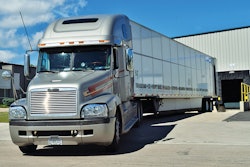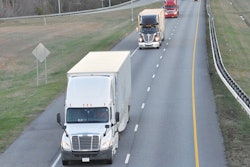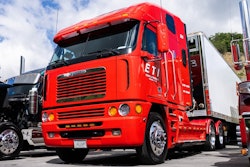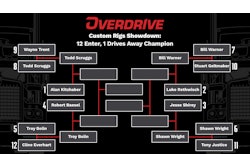PARTNERS IN BUSINESS TABLE OF CONTENTS »
Good planning and recordkeeping help keep those payments at a minimum
Among the biggest challenges in operating your business is understanding how you are taxed.
This is an area where many new owner-operators run into problems. You can avoid any big surprises on April 15 by using good planning and recordkeeping throughout the year.
As an owner-operator, you now are responsible for paying your taxes yourself and calculating the net profit for your business. For anyone who was a company employee, this is a major change. It was your employer’s responsibility to deduct all required taxes from your paycheck, which then were reported on the W-2 you received in January of the following year.
Now you will receive a Form 1099 MISC, which shows the gross earnings your carrier reported to the Internal Revenue Service.
Your weekly settlement statements and receipts provide the explanations for the deductions that will help you arrive at your net pay. If you examine the weekly net pay of a typical company driver, you might conclude that owner-operators make more than twice the money.
But no taxes are deducted from owner-operators’ settlement sheets or payments from brokers and shippers, to say nothing of expenses.

Furthermore, owner-operators do have to pay the same taxes as the company employee, plus the employer’s share of the Social Security and Medicare taxes (both considered self-employment taxes). As an employee, only 50 percent of the self-employment taxes were deducted from your pay, but as an owner-operator, 100 percent of these taxes must be paid on the net profit of your business.
Both are paid on Form 1040 at the end of the year, but estimated tax payments must be made each quarter. They’re often 20 percent to 30 percent of the net income received over the quarter. Complying with this regulation not only avoids a penalty, it also eliminates any surprise of a huge tax bill as April 15 approaches.
TYPES OF TAXES
SELF-EMPLOYMENT TAXES. These equate to the Social Security and Medicare withholdings paid through a company for employees. For 2018, rates are unchanged from 2017 at 15.3 percent. This is made up of 12.4 percent Social Security tax and 2.9 percent Medicare tax.
FEDERAL AND STATE INCOME TAX. This is calculated on your tax return. As a company employee, this amount was estimated and withheld from your check. As an owner-operator, you are responsible for its estimation and payment.
ESTIMATED TAX PAYMENTS. Those who expect to owe at least $1,000 in tax after subtracting withholding and credits are required to make quarterly payments of self-employment taxes and federal and state income taxes. Though the IRS allows estimates based on the prior year’s data, owner-operator financial services provider ATBS uses current data to compute estimated taxes due.
For payment vouchers and addresses for IRS estimated payments, as well as other federal tax information, visit www.irs.gov. Each state that imposes income taxes has a website to obtain their payment vouchers and addresses.
The IRS works like any other business. If you make a late payment, or no payment, it is authorized to apply penalties and interest based on the amount of tax due.
DEDUCTIONS AND RECORDKEEPING
Owner-operators have to estimate the profit of their business so that estimated tax payments can be made. The profit also is used to calculate the taxes due at the end of the year when the Form 1040 is filed. The profit equation you should use is:
GROSS PAY (as reported on 1099-MISC) – ALLOWABLE BUSINESS EXPENSES = NET PROFIT
If you fail to show deductions or file a tax return, the IRS will determine the taxes that are due based on their estimate of your income from 1099s provided by your business partners and not consider your deductions/expenses. This amount certainly will be much higher than you otherwise would have been required to pay.
As an owner-operator, you have many deductible expenses. The main criteria in determining deductibility are whether you have a record of the expense and whether it is an ordinary and necessary business expense. Other than honesty, the best protection from audits and penalties is good recordkeeping. Keep all records that support every deduction you claim on your tax return, beginning with your logbook for those per diem deductions.
With electronic logs, make sure you download your books every month or so for tax purposes; a leasing carrier is not likely to keep them beyond the time required for compliance.
Save and label expense receipts, maintain an expense log or spreadsheet, and sort it all at the end of every run.
A receipt is the most obvious evidence of a deductible purchase, but you also can use canceled checks, bills, credit card statements, invoices, an expense notebook – anything showing when, where and what you bought and how much you paid.
Don’t be too quick to label expenses “miscellaneous,” either; the more specific you are, the better.
Don’t forget to collect receipts for lumper fees or any expenses automatically charged to your credit card such as tolls, scales and credit card fees. Many owner-operators maintain separate credit cards for business and personal use just to simplify keeping track of such expenses.
Don’t overspend on supplies, equipment and services in your zeal to accumulate deductions. Only a portion of those expenses will be recouped through your tax filing. IRS Publication 552 goes into aspects of keeping records you might not have considered, such as the kinds of records to keep and how long to keep them.
You can download the publication “Recordkeeping for Individuals” from www.irs.gov or have it mailed by calling (800) 829-3676.
PER DIEM EXPENSES
The per diem is the tax-deductible amount the IRS assumes you spend on meals, beverages and tips when you’re away from home on an overnight business trip.
The new tax law, the Tax Cuts and Jobs Act (TCJA), effective Jan. 1, 2018, does not allow a taxpayer to deduct unreimbursed business expenses as an itemized deduction on Schedule A.
This was passed in an effort to simplify tax preparation since most taxpayers do not itemize their deductions.
For company drivers, per diem is considered an unreimbursed business expense and therefore is no longer deductible.
The only way a company driver can benefit from per diem under the TCJA is if the carrier reimburses per diem as part of the driver’s pay.
Per diem for owner-operators is an ordinary and necessary business expense reported not as an itemized deduction, but as a business expense on Schedule C. It directly reduces the self-employment taxes and income taxes owed on the return.
It’s important to realize you can’t deduct your total per diem from your tax bill dollar for dollar. But owner-operators still can deduct 80 percent of the total per diem of $63 a day, or $50.40.
There’s the option of direct expense deductions, but meals are deductible at only a 50 percent rate, so an owner-operator would have to consistently spend more than $100.80 per day to exceed the per diem’s $50.40 (80 percent of the $63).
To claim the per diem on any trip, you must be away from home for the night, which you can prove through your logs.
A trucker who leaves the terminal before dawn, works a 14-hour day and then returns that night has not worked a single day for the per diem deduction by IRS standards because he didn’t spend the night somewhere.
DEPRECIATION
The standard depreciation for a Class 8 truck, commonly called “straight-line” depreciation, is an evenly paced three-year deduction that’s spread over four tax years: year one, 17 percent of the cost of the truck; years two and three, 33 percent each; year four, 17 percent.
Also common is a variation of the four-year formula known as accelerated depreciation. It takes 77 percent of the equipment’s value in the first two years, 23 percent in the final two.
As a result of the new TCJA legislation, if an owner-operator chooses, he or she may deduct 100 percent truck and trailer purchases until the end of 2022.
Starting in 2023, this bonus depreciation deduction dwindles 20 percent a year until 2026, and it’s eliminated in 2027. However, the bonus depreciation deduction can be taken only in the year the equipment was purchased.
Another change made under the new tax law is that bonus depreciation can be used for both used and new assets.
Under the previous tax law, bonus depreciation was allowed only on new assets.
Should equipment expenses exceed operators’ income for the year, which is likely for the year the equipment is bought, the bonus depreciation deduction cuts income to zero. The new legislation allows them to carry that loss forward into the next year, which could help lower their tax bill for that year and even subsequent years. When the bonus depreciation rate begins to fall in 2023, owner-operators likely will return to using the standard depreciation deduction.
Accelerating depreciation like this, however, is no magic bullet. It’s not for everyone, given it could speed the higher tax bills that come when depreciation runs out. That also could move the taxpayer into a higher tax bracket.
Too many owner-operators have used a similar tactic attempting to catch up after they’ve failed to make their estimated quarterly taxes.
Owner-operators with a full tank of financial self-discipline can use bonus depreciation to zero out tax bills as long as possible while also diligently saving enough each year — typically 8 percent of gross revenue — for the inevitable day when the IRS comes calling.
LEASE VS. PURCHASE: A TAX ANALYSIS
If you are leasing your truck, you can deduct the entire amount of the payment each month.
Example 1: Tom leased his truck Jan. 1. He is paying $2,000 per month. His total deduction is $24,000 ($2,000 x 12).
On the other hand, if you are purchasing your truck, you can deduct the depreciation on the total cost of the truck and the interest charges that are included in your payment. The truck is depreciated through accelerated depreciation over three years.
Example 2: Tom purchased his truck Jan. 1. The price is $60,000. He is paying $2,000 per month for four years to pay off the truck, 80 percent of which is interest in the first year.
His depreciation deduction in year one is 33 percent of $60,000, or $19,800. His interest deduction is $19,200. His total deduction is $39,000.
As these examples illustrate, the owner-operator who is purchasing his truck has deductions in the first year that are $10,200 greater than the lease driver. But in the fourth year, the lease driver still will have his $24,000 per year, and the purchaser will have $19,800 of depreciation left plus interest of $4,800 to deduct.
The purchaser gets higher deductions in the first three years with the fourth year close to equal. The net effect is a tax delay for the owner-operator purchasing the truck. The tax will be paid in later years, not eliminated by depreciation. Note also that if you trade every three years, erosion of depreciation may have set in by your fourth or fifth trade, and you’ve lost much of the tax benefit enjoyed by people who buy less often.
On the other hand, considered financially, it usually costs less to buy in the long term. Take, for example, the common five-year lease period measured against the likewise common five-year note on a new truck.
With a purchase price of $118,000 for an aerodynamic truck with a 70-inch sleeper and a comparable lease of the same truck, tax savings are greater with the lease – almost $7,000 more over five years.
However, all other things being equal, it makes more sense financially to buy since the total adjusted cost of the vehicle with conventional loan financing is $10,000 less than the cost of the leased vehicle after a 20 percent buyout at the end of the term. For more on this tough financial choice, see Chapter 10.
MINIMIZING YOUR TAXES
Following are examples of tried and proven tax reduction tips:
GET HELP. The U.S. Internal Revenue Code is 3.4 million words long. In type this size, it would fill at least 60 issues of Overdrive magazine, with no room for photos or ads. That’s why owner-operators need a business services provider who specializes in owner-operator businesses.
SAVE MONEY TAX-FREE. If you don’t have a retirement account, start one. Up to a point, the money you put into an IRA, SEP or 401(k) is tax-exempt until you start drawing it out many years later. Put money into it regularly.
TRACK PERSONAL VEHICLE MILES. You cannot deduct mileage on your personal vehicle to get to and from work, but you can deduct it if you make a business-related trip to the bank, the post office, a business meeting, a truck show, a dealership, a supply store or a parts yard – even to a grocery store if your purchases were business-related. Keep a log in which you note the date, mileage and purpose of each business-related trip.
For tax year 2018, the IRS deduction for business miles is 54.5 cents. There are also smaller deductions for other personal-vehicle miles: 18 cents for medical-related trips, and 14 cents a mile for charitable trips such as Meals on Wheels deliveries.
GIVE TO GOOD CAUSES. Donations to churches, charities such as the Red Cross and the Salvation Army, and nonprofits like Trucker Buddy all are tax-deductible if you itemize your taxes. Gifts to business associates are tax-deductible but limited: $25 in gifts per associate per year.
HIRE THE KIDS. If you put an adolescent child on the payroll and pay her, say, $4,000 for the year, she pays no taxes on the income because she didn’t make enough – but you pay no tax on it, either. Make sure the kids are doing age-appropriate work, and keep documentation of it, including filing a W-2.
CLAIM TUITION TAX CREDITS. If you’re paying tuition for yourself or your children to a qualified educational institution, take the tuition tax credit – a dollar-for-dollar savings off your tax bill, up to $2,500. Paying the full tuition by Dec. 31 will allow you to credit the entire amount on your taxes.
This only works for students seeking an undergraduate degree and enrolled at least half-time. There is a four-year limit on this credit.
USE THE CALENDAR. Keep a trucking-specific tax calendar at your home or in your truck. You can find one on the ATBS website containing important tax deadlines throughout the year and frequently missed tax deductions.
Before Dec. 31, buy whatever big-ticket business equipment you know you need: new tires, a laptop or an in-cab heater. Even if you buy it on credit, you get the tax benefit quickly while postponing the cost.
Deductions must be business-related. Here are a few examples:
• If you wash your truck at home, you can claim the cost of household water and detergent for washing the truck.
• You can deduct a flyswatter for your truck, flashlight batteries, cleaning supplies and a bunk comforter.
• You can deduct an entertainment expense if you buy dinner for a driver you are trying to recruit for your company.
• You can deduct coveralls, but not blue jeans. You can deduct steel-toed shoes, but not tennis shoes.
IRS AUDITS
The IRS usually has three years to challenge deductions or income stated on your return by requesting an audit, so you should keep your records for at least three years.
The statute of limitations can be up to six years for returns where there is evidence of an understatement of income of 25 percent. If the return is found to be fraudulent with the intent to evade tax, or if no return is filed, an action can be brought against you at any time.
The fact that the IRS is auditing your return does not mean that you or your CPA made a mistake. The IRS periodically randomly selects some returns to determine compliance with its tax rules.
If you receive a notice you are being audited, the first thing you should do is contact the person who prepared your return.
However, only a Certified Public Accountant or Enrolled Agent can represent you in an audit. The IRS says 4 percent of tax returns filed by the self-employed with at least $100,000 in revenue get special attention.
Claiming substantial expenses not common to a single-truck owner-operator — such as utilities, advertising or inventory — might draw an audit. The reality of the owner-operator world is that a single engine rebuild can spike expenses for the year; income also can be volatile, especially for independents. If circumstances such as those put you among the one in 25 who meet face to face with the IRS, make sure you’ve got the documentation.
The ATBS Tax Resolution team specializes in helping owner-operators who get behind on their taxes and can assist with wage garnishments, IRS tax liens, IRS representation, audits, offers in compromise and more. Consultations with the ATBS Tax Resolution team are free and confidential.
You ultimately are responsible for your tax return. Some tax preparers are aggressive in claiming deductions; be aware of what’s being submitted on your behalf, and make sure you’re comfortable with it.
Download the entire Partners in Business Manual
Chapter 1: Becoming your own boss
Chapter 2: Bookkeeping and business analysis
Chapter 3: Understanding your revenue and costs
Chapter 5: Controlling fuel costs
Chapter 6: Controlling tire costs
Chapter 8: Income tax and other taxes
Chapter 9: Choosing a business structure
Chapter 10: Truck buying, leasing, financing
Chapter 11: Choosing a trailer
Chapter 12: Maintaining your equipment
Chapter 13: Choosing a carrier
Chapter 14: Computers, mobile devices and the internet
Chapter 15: Staying compliant and safe
Chapter 16: Trucking insurance












